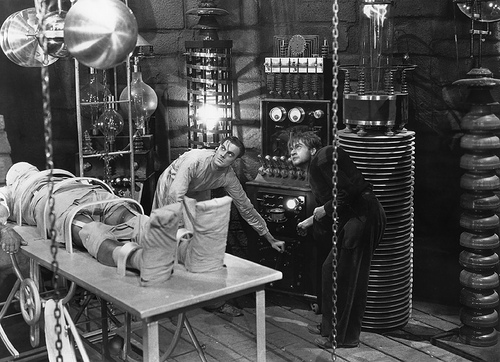Published on
Will Badging Overcome or Feed “The Frankenstein Effect?”

In a recent conference session, Al Byers, a colleague from the National Science Teachers Association, referred to “the Frankenstein Effect”—the result when a bunch of existing parts are patched together to create something. The result is generally not pretty… or functional.
Some people worry that the badging movement would result in a series of badges that don’t really hang together to create ore represent the desired competence or expertise. They express that fear as if it is inevitable in badging systems, and as if it doesn’t already exist. But the Frankenstein effect is alive and well in all too many formal education programs. A typical degree is a patchwork of parts (courses) that were appended in a rather flexible sequence. There may or may not be help in making sense of the pieces as or after they are acquired. Rustum Roy once wrote an editorial that likened the college student experience to buying a BMW part by part and with the expectation that they would put it together on their own. It seems a fair criticism to me, and it was about today’s product – not the innovation, badging.
But in fact we can and must assemble parts. Life happens in parts, and we make sense of it. We learn as we grow, putting things together (crudely at first) and then refining our understanding as we give it more thought and as we apply what we have come to understand and see how reality sets us straight. Sometimes that synthesis is facilitated in a formal way. Many degree programs have capstone seminars and/or projects that cause students to synthesize their learning under the supervision of professors and/or professionals. Others programs don’t ensure that this happens—they let Frankenstein lumber off into the village. Sometimes synthesis is left to the student to accomplish in an informal way, and many times that works out. We are learning, integrating machines. We all learn, basically all the time.
I suspect that you are thinking that I was being too rough on the status quo. But that’s because the new educational option (in this case badging) is routinely subject to scrutiny that the status quo (in this case courses and letter grades) would not survive. I acknowledge that I portrayed worst-case scenarios to representing existing degree programs, just as badging critics broadcast the worst case scenarios for badging. So let’s stop the horror movies, avoid writing fairy tales in their place, and take a realistic view.
Badging is simply a form of micro-certification that implies that we define all the things that really matter (knowledge, skills, characteristics, and synthesis), figure out how we are going to measure them, and acknowledge students who master these things. If we use badging wisely, we’ll build a continuum of learning experiences at a much finer “grain size” that can be assembled with better results that when we assemble courses. We’ll want to offer badges for the synthesizing, too, to make sure that the insights people need to develop across badges have been acquired, but that’s doable. Well, it’s doable in institutions and organizations willing to do the hard work that real assessment (and badging) requires.
In a response to my last post to The EvoLLLution blog, WA Anderson said, “I’m not sure if digital badges will spell the difference between relevance and irrelevance for higher education… It’s the mind-set that comes with accepting the badges that will define higher education’s progress.”
That’s right. There’s no magic in the badges. It’s the shift in mindset and the fact that they cause good assessment that makes me believe good things lie ahead. But it’s people who will determine that.
Comments, anyone?
Author Perspective: Educator



